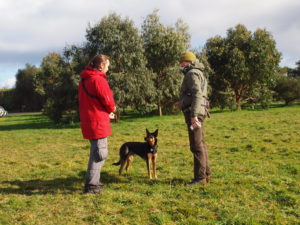Otways Conservation Dogs – FAQs
Why is there a need for Conservation Dogs in the Otways?
The Tiger Quoll is the largest remaining carnivorous marsupial on the Australian mainland. It is an endangered species and is declining across its entire range, even in the Otways which was once a key habitat for the Tiger Quoll.
One great way for detecting an elusive animal while causing minimal impact is through finding scats (poos). Scats contain DNA fragments and these can be extracted and analysed to gain insights into the population through a better understanding of their genetics.
Until 2012 there was no confirmed evidence of Tiger Quoll presence in this region for nearly a decade. This year the Conservation Ecology Centre discovered scats of two different Tiger Quolls in different areas of the Otways. Both these scats were discovered by chance and you can read more about each discovery here. Dogs have highly sensitive noses and can be trained to find a target scent – through teaming up with man’s best friend we can greatly increase the efficiency and effectiveness of our detection efforts.
Who are the Otways Conservation Dogs?
The project is led by the Conservation Ecology Centre, working in collaboration with Canidae Development* and the 2012 program has been proudly supported by the Mazda Foundation.
The team is comprised of canine volunteers from our community and their people – an incredible group who are working together, learning from one another and contributing to the conservation of the region.
How do you make sure the Quolls are not affected by the dogs?
We are working in very environmentally sensitive areas and are careful to minimise the impacts of our activities. Otways Conservation Dogs are trained to find the evidence of Tiger Quolls not the animal itself; in this case we are searching for Tiger Quoll scat (poo). Our training is about detection and the dogs are trained to perform a passive alert behaviour of dropping (or sitting for the very little dogs in the team!) on locating a scat sample. There is absolutely no barking, scratching or digging and the dogs do not interact directly with the scent source.
Highly trained dogs and handlers are assessed according to strict criteria for operational readiness. When dogs are operational they are deployed according to protocols under the direction and supervision of a Conservation Ecology Centre representative.
Otways Conservation Dogs are taught not to be distracted by other animals as part of their training – our dogs are not allowed to chase any animal at any time (this includes wildlife, domestic and pest species). In fact, our dogs are so well trained around wildlife that the wild kangaroo mob often hangs around on a Sunday morning to watch our training sessions!
What sorts of dogs make good detection dogs?
 Our team comprises a wide range of dog breeds and personalities – from gutsy Jack Russels and happy Bishon Frise to eager German Shepherds, conscientious Australian Shepherds, delightful Golden Retreivers, smiley Spaniels, focused Kelpies and bouncy Border Collies – to name a few!
Our team comprises a wide range of dog breeds and personalities – from gutsy Jack Russels and happy Bishon Frise to eager German Shepherds, conscientious Australian Shepherds, delightful Golden Retreivers, smiley Spaniels, focused Kelpies and bouncy Border Collies – to name a few!
Our skilled instructor from South West Victorian Dogs brings out the very best in each dog/handler team, working together with everyone to find the training approach which best suits each combination. We have seen incredible advancements in every single member of the team – both human and canine.
Our team members live both locally and quite far away, with some members rising at 4am to make our Sunday morning training sessions.
How can I get involved?
The project is currently running at capacity, however, if you are interested in getting involved we welcome you to get in touch via our contact form and we can discuss the opportunities for the future. There are certainly ways to get involved with this project even if you don’t have a dog!
 Learn more about Tiger Quolls.
Learn more about Tiger Quolls.
Learn more about the Tiger Quoll Conservation Program.
Read up on the Conservation Ecology Centre’s 2012 discoveries of Tiger Quolls in the Otways – the Eastern Otways scat and the Cape Otway scat.
Learn more about the Otways Conservation Dogs Project.
*We began working on this project with South West Victorian Dogs but Luke Edward’s work has quickly outgrown the scope of the SWVD organisational structure. Canidae Development was launched in July 2013 and we are delighted to have been able to witness this evolution – it is an exciting time for dogs in conservation.